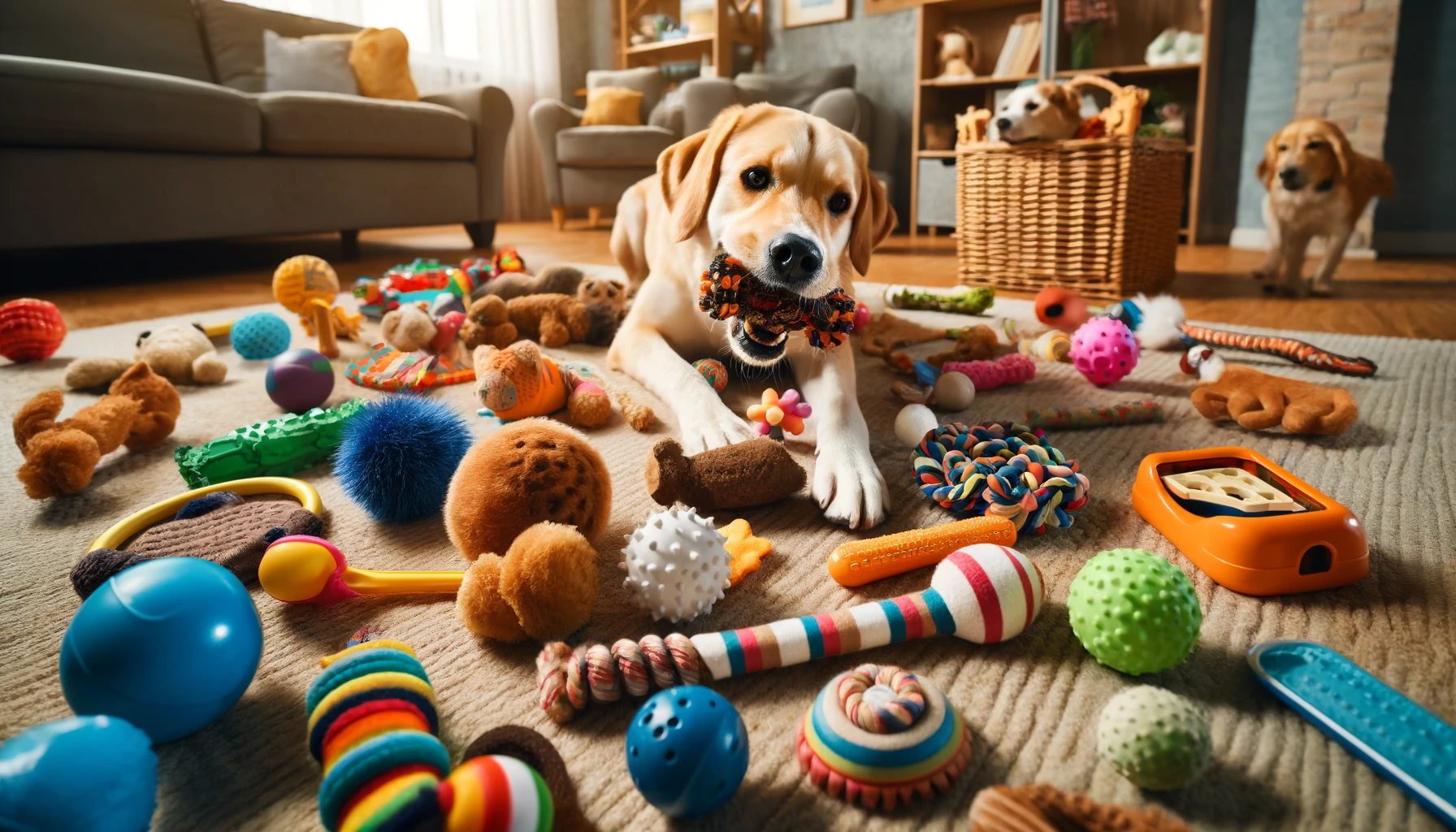Dogs are playful creatures by nature, and keeping them entertained is essential for their physical and mental well-being. Toys play a crucial role in providing stimulation, exercise, and bonding opportunities for both you and your furry friend. In this comprehensive guide, we will explore various types of toys available for dogs, the benefits of each type, and how to choose the best toys for your pet based on their age, size, and personality.
Understanding the Importance of Play
Physical Benefits
Play is vital for a dog’s physical health. Regular exercise helps maintain a healthy weight, reduces the risk of obesity-related diseases, and strengthens muscles and joints. Engaging in play also enhances coordination and agility, essential for overall fitness.
Mental Stimulation
Toys provide mental stimulation that can prevent boredom and destructive behaviors. Interactive toys challenge your dog’s problem-solving skills and keep their minds sharp. Mental engagement is particularly important for high-energy breeds or dogs that are prone to anxiety.
Emotional Well-Being
Playtime fosters a bond between you and your dog, enhancing your relationship. Toys can also alleviate stress and anxiety, providing comfort during times of change or uncertainty, such as moving to a new home or the arrival of a new family member.
Types of Dog Toys
When it comes to dog toys, there’s a wide variety to choose from. Below are the main categories, each serving different purposes and benefits.
1. Chew Toys
Chew toys are designed for dogs that love to gnaw and chew. They can help keep your dog’s teeth clean and satisfy their natural urge to chew.
Benefits:
- Promote dental health by reducing plaque and tartar buildup.
- Satisfy natural chewing instincts, which can prevent destructive chewing on furniture or shoes.
Popular Options:
- Nylon Bones: Durable and long-lasting, they come in various flavors.
- Rubber Chew Toys: Such as KONGs, which can be stuffed with treats for added interest.
- Rawhide Chews: While popular, be cautious with these as they can pose choking hazards if not monitored.
2. Interactive Toys
Interactive toys are designed to engage your dog mentally. They often involve puzzles or challenges that require your dog to think critically to access a reward, typically a treat.
Benefits:
- Provide mental stimulation, preventing boredom.
- Encourage problem-solving skills and cognitive development.
Popular Options:
- Puzzle Toys: These require your dog to move pieces around to access treats.
- Snuffle Mats: These mats mimic grass and encourage dogs to sniff out hidden treats.
- Hide-and-Seek Toys: Plush toys that encourage your dog to find smaller toys hidden within.
3. Fetch Toys
Fetch toys are designed for playing fetch, which is one of the most popular games among dog owners. These toys are typically durable and easy for dogs to carry.
Benefits:
- Provide excellent exercise, promoting cardiovascular health.
- Strengthen the bond between you and your dog through interactive play.
Popular Options:
- Tennis Balls: Standard balls for fetch but ensure they are durable and made specifically for dogs.
- Frisbees: Soft frisbees are ideal for gentle play and are less likely to cause injury.
- Retrieve Dummies: These are designed for dogs to carry back and forth.
4. Tug Toys
Tug toys are ideal for interactive play between you and your dog. They promote bonding and can provide excellent physical exercise.
Benefits:
- Strengthen the bond between you and your dog through cooperative play.
- Promote muscle strength and improve your dog’s grip and bite.
Popular Options:
- Rope Toys: Durable and perfect for tugging. They can also help clean your dog’s teeth.
- Rubber Tug Toys: These provide a good grip and are often more durable than fabric toys.
- Tug-of-War Toys: Designed specifically for tugging, these can come in various materials and styles.
5. Plush Toys
Plush toys are soft, cuddly toys that many dogs enjoy carrying around or snuggling with. They can provide comfort and companionship.
Benefits:
- Provide comfort and security, especially for puppies and anxious dogs.
- Encourage gentle play and can be used for fetch in soft environments.
Popular Options:
- Stuffed Animals: Many dogs enjoy plush toys that resemble animals.
- Squeaky Toys: These combine plush material with squeakers, adding an extra layer of fun.
- Interactive Plush Toys: Toys that involve hidden squeakers or compartments for treats can engage your dog further.
6. Balls
Balls are classic toys that dogs love. They are versatile and can be used for fetch, rolling, or even solo play.
Benefits:
- Encourage exercise and cardiovascular fitness.
- Promote natural chasing instincts in dogs.
Popular Options:
- Rubber Balls: Durable and often have bounce, making them fun for fetch.
- Tennis Balls: Soft and lightweight but should be monitored for wear and tear.
- Ball Launchers: Devices that help throw balls farther, giving your dog more exercise with less effort on your part.
7. Specialty Toys
Some toys are designed for specific purposes or are tailored to unique dog needs.
Benefits:
- Address specific behavioral issues or health needs.
Popular Options:
- Cooling Toys: Filled with water or gel that can be frozen, these help keep dogs cool during hot weather.
- Treat-Dispensing Toys: These release treats as your dog plays, providing an added incentive for engagement.
- Anxiety Relief Toys: Designed to soothe anxious dogs, often using calming scents or weighted materials.
Choosing the Right Toys for Your Dog
Consider Your Dog’s Size
The size of the toy should be appropriate for your dog. Small toys can pose choking hazards for larger dogs, while large toys may be too cumbersome for small breeds.
Assess Your Dog’s Activity Level
High-energy dogs may require more interactive and durable toys, while older or less active dogs might prefer plush or softer toys.
Evaluate Your Dog’s Chewing Habits
If your dog is an aggressive chewer, look for toys labeled as “durable” or “indestructible.” For light chewers, softer toys may suffice.
Age Considerations
Puppies have different toy needs than adult dogs. For instance, teething toys can help soothe sore gums in puppies, while older dogs may benefit from softer toys that are easier on their teeth.
Supervision and Safety
Always supervise your dog during playtime, especially with new toys. Check toys regularly for signs of wear and replace them if they become damaged to prevent choking hazards.
Engaging Your Dog with Toys
Rotate Toys
To keep your dog engaged, consider rotating their toys regularly. This keeps their interest piqued and can prevent boredom.
Teach Commands with Toys
Use toys as tools for training. Teaching commands like “fetch,” “drop it,” or “leave it” can be more engaging when using their favorite toys.
Incorporate Toys into Daily Routine
Integrate toys into your dog’s daily routine. Use them during walks, play sessions, and even as rewards for good behavior.
Group Playdates
Organizing playdates with other dogs can provide social interaction and encourage active play. Toys can facilitate these interactions, ensuring everyone stays engaged.
DIY Dog Toys
Creating DIY dog toys can be a fun and cost-effective way to provide entertainment for your pet. Here are a few simple ideas:
1. T-shirt Tug Toy
Materials: Old t-shirts
Instructions:
- Cut the t-shirts into strips.
- Braid the strips together tightly.
- Tie off the ends to secure the braid.
2. Sock Ball
Materials: Old socks and a tennis ball
Instructions:
- Place the tennis ball inside one sock.
- Tie a knot in the sock to secure the ball.
- You can add a second sock for more durability.
3. Treat-Dispensing Bottle
Materials: Plastic water bottle
Instructions:
- Remove the label and cap from the bottle.
- Cut small holes in the bottle, big enough for treats to fall out.
- Fill the bottle with your dog’s favorite treats and let them figure out how to get them out.
4. Snuffle Mat
Materials: Fleece fabric, rubber mat
Instructions:
- Cut fleece into strips.
- Tie the strips to a rubber mat, creating a “grass” effect.
- Hide treats within the strips for your dog to find.
Troubleshooting Common Toy Issues
1. Loss of Interest
If your dog loses interest in their toys, consider introducing a new toy or rotating existing ones. Engaging in playtime with them can also rekindle their interest.
2. Destructive Behavior
If your dog becomes destructive with toys, evaluate the type of toys you’re providing. Choose more durable options for aggressive chewers and supervise playtime to prevent destructive behaviors.
3. Safety Concerns
Regularly inspect toys for wear and tear. If you notice any damage or small parts that can be chewed off, it’s best to replace the toy immediately to prevent choking hazards.
Conclusion
Choosing the right toys for your dog can enhance their quality of life by providing entertainment, exercise, and mental stimulation. By understanding your dog’s individual needs and preferences, you can select toys that will keep them engaged and happy. Remember to regularly evaluate and rotate toys to keep playtime fresh and exciting. With the right toys, you can strengthen the bond between you and your furry friend, making playtime an enjoyable experience for both of you.
Additional Resources
- Books: “The Art of Raising a Puppy” by the Monks of New Skete provides insights into effective training and playtime strategies.
- Websites: The American Kennel Club (AKC) offers resources on dog breeds, training tips, and toy recommendations.
- Dog Training Classes: Consider enrolling in local classes to learn more about engaging play techniques and effective training methods.
With a variety of toys and engaging activities, you can ensure your dog leads a fulfilling and happy life, filled with joy and play.

